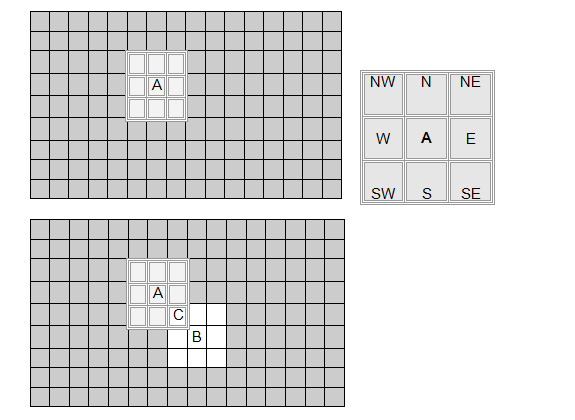This project has been developed by Kevin McCourt, artist and Bartolo Luque, theoretical physicist.
This practical experiment will focus on social interaction, with more than a hundred creators collaborating in the making of two collective works: One a story, the other a picture. Each person will participate, using their own computer (client), by designing a small part of the collective work which will be housed in a central computer (server).
The projects will address how we are influenced by others as we form and communicate across networks.
They will allow us to also explore relationships between scientific (Physics) techniques for understanding collective human behaviour and philosophical and psychological concepts related to individual experience, sensation and perception which form part of such social phenomena.
The process (events) could be described as follows:
(1) A Story.
Let’s imagine a group formed by 100 writers using their own computers. Each writer writes one line of the 100 which make up the final story. The server randomly assigns a number, from 1 to 100 to each participant. The writers do not know their number, that’s to say, the positioning in the story of the line that they are going to write.
In this experiment, we will fix a radius of visibility, which consists of the number of lines above and below their own, that the writer can see. If the radius is, for example, R=1, writer 46 will see, in real time thanks to the server, how neighbouring writers are changing lines 45 and 47. Beforehand, each writer will be encouraged to search for “narrative coherence” (whatever that may mean) with neighbours’ contributions. S/he will be able to modify their sentence, if s/he feels it is necessary, whenever s/he wants in order to adapt it to the modifications made by neighbours.
If the radius were 0, there would be no interaction. The sentences would be totally independent with null narrative coherence. If the radius were the maximum possible and the writer could see the whole story as it develops, each writer would see 99 lines continuously changing, overwhelming him/her with an excess of information and making it impossible for him/her to change his line adequately. We expect that there is a critical value for the radius of visibility related to the number of writers which would lead to the most interesting stories with specific regard to content.
The case of those at the extremes of the story, that is to say, at the “beginning” and the “end” (writer number 1 and writer number 100), are especially relevant. If a writer cannot see sentences above, s/he will know that his/her number is 1, and if they cannot see anyone below, s/he will know that his/her number is 100. This information will push them to write a beginning or an ending respectively, despite the “pressure” of his/her neighbours. However, we could repeat the experiment, changing the settings in order to make them periodic. We can do this by closing the circle: 100 now sees 1, 2 etc. below, and number 1 sees numbers 100, 99 etc. above. In this way, no writer is aware of his/her position in the text. Will a circular story emerge, without a beginning or an end, or will certain writers take it upon themselves to write a beginning or an ending?
(2) A Picture
A constantly evolving picture or film, produced by a large number of online participants (dispersed agents), using their own computers wherever they may be, will be projected in real time on a cinema screen.
Let’s imagine there are now a total number of 144 (16 x 9) online participants, all making the artwork together, with each participant painting the content of one square, as shown below. This square will be assigned randomly to each participant by the server. Each participant will see, in real time, what his/her eight neighbours are painting in their square (in the illustration below, we can see participant A and his 8 neighbours) and will decide how to modify his/her square in order to achieve “aesthetic cohesion” (whatever that may mean).
Participants will in this way be subject to the influence of a small group of neighbours, while participating in a process involving a much wider community of agents.
As a public event, we would like to project the evolution of such pictures or stories on cinema screens as they are collectively designed during that same event.
We will publicly present our findings on the collective creative process. This analysis will simultaneously travel along two parallel routes, the first scientific (Physics) and the second informed by Philosophy and Psychology. These findings will focus on both experiments carried out earlier with students from the UPM and the aforementioned public events.
The Physics of complex systems has the mathematical tools required to describe emergent phenomena, which we expect could be applied to analysis of collective creativity.
Factors such as autonomy, self-interest, altruism, collective interest, negotiation, translation, cooperation and collective intelligence are all concepts of interest to this project.
From a philosophical viewpoint, we are interested in the relations between collective behaviour and individual experience. For example, Humberto Maturana and Francisco Varela’s biological theory of autopoiesis and contemporary philosophical theories of individuation both attempt to understand the continual process of change or becoming experienced by the individual in relation to the milieu.
This project will clearly be of interest to audiovisual arts practitioners, scientists and philosophers interested in cross-disciplinary themes, but also to the general public whose participation and contribution as collaborative artists will be immediately accessible and visible.

